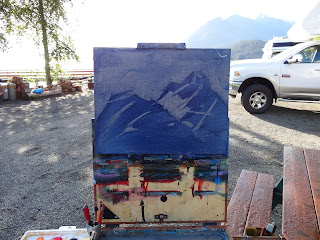Now make the starts - I say making a start because that is the mind set I need to have. From experience I know that the chance of making a finished painting on location is slim; the chance of making something ( a start) that, with thoughtful reflection and freeing yourself from the limitations of the reference, there is a good chance you can make a painting that will stand on its own - be both interesting and one that will read ( represent what you are wanting it to represent). Those finishes can be made at home under controlled conditions or often in my case from my RV. I rarely use reference photos - but just use my imagination helped by a lot of plein air to make the finishes that satisfy me.
And that is the trick for me - going far enough with the piece to capture the shapes and value pattern that the location suggests but not so far that I am committed to details or have gone to the point of not being able to save the work . I would far rather start two or three paintings and take them only to the point that I need to think carefully before I overwork them, than to make one finished painting on site that is generally not as strong as any of the three starts would be once I carefully consider my next moves for them.
My acrylic plein airs are generally larger than my oil starts - 11x14, 12x16 and 14x18. I work on 1/8 door skin - with gessoed linen or canvas mounted . I either start with a toned canvas or tone it once I select my subject.
I select my subject fairly carefully - one of the best pieces of advise I got was from Robert Watts in San Diego - when painting on location always pick a battle you can win - or one that you can turn into a battle you can win (last part mine). I always make one or more thumbnail sketches ( as described earlier) identifying the shapes to be included ( having decided what to exclude) and placing each in one of three values. I transfer the rough sketch to the canvas with water soluble colour pencil. I then make the final sketch with either graphite pencil, china marker or black marker ( Sharpie) depending on the subject.
Then I get to it. Sometimes I apply a dark transparent over the canvas and use my shaper to create a three value pattern ( see earlier posts) then go from there. Other times I block in my darks using transparents and go from there.
Did a couple of days of plein air from our RV. These are some of the first acrylic plein airs I have done this season - so I started with a very simple subject - light hitting the snow on a mountain peak.
 |
| Notice the neutral value and colour of the linen with clear gesso- pencil sketch |
 |
| Prussian Blue Golden Liquid and medium |
 |
| Shaper used to create value pattern - got to move fast |
 |
| Not sure what to do next? ? that means that is far enough |
Next, pulled my cart to the boats and started again. In this case I did my pencil sketch and then outlined the important lines lightly with the Sharpie. Then I played with a mix of warm colour to create a warm underpainting, then got at the opaques to "carve" the shapes.
Set them up as a group, glass of wine and consider each. I always carry a mix of frames. Tried the first in a smaller, horizontal format frame and liked it better -need a cut down at home.
 |
| Try the 11x14 in a 8x12 frame - simple subject and like it better |
 |
| Might be enough to make it a finished sketch |
Next day, new location. First off the back of my pick up. Two starts of the same scene. Draw one, put on the underpainting glaze and shape the values. Its 6 AM and the paint is drying slowly so while the first is drying make the second sketch and using a different transparent glaze shape its value pattern.
Later that day a few more.
.JPG) |
| Stop, set it away from the reference and consider |
.JPG) |
| A few changes made, then frame on site and consider more. Then take home to decide if it could become a painting. |
 |
| My (our) living room for a week or so after a plein air trip. |




.JPG)
.JPG)
.JPG)
.JPG)
.JPG)
.JPG)
.JPG)
No comments:
Post a Comment
Thanks for your feedback.